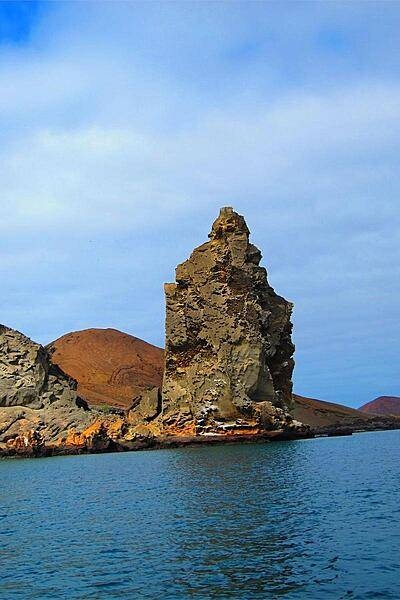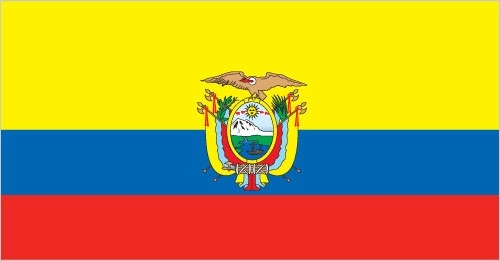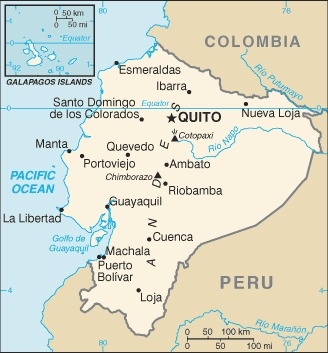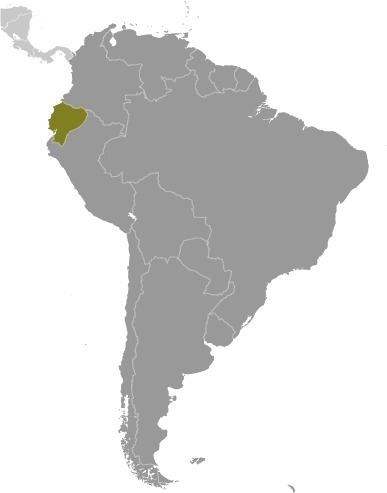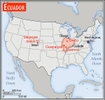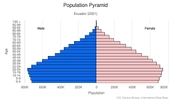Introduction
Background
What is now Ecuador formed part of the northern Inca Empire until the Spanish conquest in 1533. Quito became a seat of Spanish colonial government in 1563 and part of the Viceroyalty of New Granada in 1717. The territories of the Viceroyalty - New Granada (Colombia), Venezuela, and Quito - gained their independence between 1819 and 1822 and formed a federation known as Gran Colombia. When Quito withdrew in 1830, the traditional name was changed in favor of the "Republic of the Equator." Between 1904 and 1942, Ecuador lost territories in a series of conflicts with its neighbors. A border war with Peru that flared in 1995 was resolved in 1999. Although Ecuador marked 30 years of civilian governance in 2004, the period was marred by political instability. Protests in Quito contributed to the mid-term ouster of three of Ecuador's last four democratically elected presidents. In late 2008, voters approved a new constitution, Ecuador's 20th since gaining independence. General elections were held in April 2021, and voters elected Guillermo LASSO president, who took office on 24 May 2021.
Visit the Definitions and Notes page to view a description of each topic.
Geography
Location
Western South America, bordering the Pacific Ocean at the Equator, between Colombia and Peru
Geographic coordinates
2 00 S, 77 30 W
Map references
South America
Area
total: 283,561 sq km
land: 276,841 sq km
water: 6,720 sq km
note: includes Galapagos Islands
Land boundaries
total: 2,237 km
border countries (2): Colombia 708 km, Peru 1529 km
Coastline
2,237 km
Maritime claims
territorial sea: 12 nm
exclusive economic zone: 200 nm
continental shelf: 200 nm
note: Ecuador has declared its right to extend its continental shelf to 350 nm measured from the baselines of the Galapagos Archipelago
Climate
tropical along coast, becoming cooler inland at higher elevations; tropical in Amazonian jungle lowlands
Terrain
coastal plain (costa), inter-Andean central highlands (sierra), and flat to rolling eastern jungle (oriente)
Elevation
highest point: Chimborazo 6,267
lowest point: Pacific Ocean 0 m
mean elevation: 1,117 m
note: because the earth is not a perfect sphere and has an equatorial bulge, the highest point on the planet farthest from its center is Mount Chimborazo not Mount Everest, which is merely the highest peak above sea level
Natural resources
petroleum, fish, timber, hydropower
Land use
agricultural land: 29.7% (2018 est.)
arable land: 4.7% (2018 est.)
permanent crops: 5.6% (2018 est.)
permanent pasture: 19.4% (2018 est.)
forest: 38.9% (2018 est.)
other: 31.4% (2018 est.)
Irrigated land
15,000 sq km (2012)
Major watersheds (area sq km)
Atlantic Ocean drainage: Amazon (6,145,186 sq km)
Population distribution
nearly half of the population is concentrated in the interior in the Andean intermontane basins and valleys, with large concentrations also found along the western coastal strip; the rainforests of the east remain sparsely populated
Natural hazards
frequent earthquakes; landslides; volcanic activity; floods; periodic droughts
volcanism: volcanic activity concentrated along the Andes Mountains; Sangay (5,230 m), which erupted in 2010, is mainland Ecuador's most active volcano; other historically active volcanoes in the Andes include Antisana, Cayambe, Chacana, Cotopaxi, Guagua Pichincha, Reventador, Sumaco, and Tungurahua; Fernandina (1,476 m), a shield volcano that last erupted in 2009, is the most active of the many Galapagos volcanoes; other historically active Galapagos volcanoes include Wolf, Sierra Negra, Cerro Azul, Pinta, Marchena, and Santiago
Geography - note
note 1: Cotopaxi in Andes is highest active volcano in world
note 2: genetic research indicates that the cherry-sized tomato originated in Ecuador without any human domestication; later domestication in Mexico transformed the plant into the large modern tomato; archeological research indicates that the cacao tree, whose seeds are used to make chocolate and which was long thought to have originated in Mesoamerica, was first domesticated in the upper Amazon region of northwest South America - present-day Ecuador - about 3,300 B.C.
People and Society
Nationality
noun: Ecuadorian(s)
adjective: Ecuadorian
Ethnic groups
Mestizo (mixed Amerindian and White) 71.9%, Montubio 7.4%, Amerindian 7%, White 6.1%, Afroecuadorian 4.3%, Mulatto 1.9%, Black 1%, other 0.4% (2010 est.)
Languages
Spanish (Castilian) 93% (official), Quechua 4.1%, other indigenous 0.7%, foreign 2.2%; note - (Quechua and Shuar are official languages of intercultural relations; other indigenous languages are in official use by indigenous peoples in the areas they inhabit) (2010 est.)
major-language sample(s):
La Libreta Informativa del Mundo, la fuente indispensable de información básica. (Spanish)
The World Factbook, the indispensable source for basic information.
Religions
Roman Catholic 74%, Evangelical 10.4%, Jehovah's Witness 1.2%, other 6.4% (includes Church of Jesus Christ, Buddhist, Jewish, Spiritualist, Muslim, Hindu, indigenous, African American, Pentecostal), atheist 7.9%, agnostic 0.1% (2012 est.)
note: data represent persons at least 16 years of age from five Ecuadoran cities
Demographic profile
Ecuador's high poverty and income inequality most affect indigenous, mixed race, and rural populations. The government has increased its social spending to ameliorate these problems, but critics question the efficiency and implementation of its national development plan. Nevertheless, the conditional cash transfer program, which requires participants' children to attend school and have medical check-ups, has helped improve educational attainment and healthcare among poor children. Ecuador is stalled at above replacement level fertility and the population most likely will keep growing rather than stabilize.
An estimated 2 to 3 million Ecuadorians live abroad, but increased unemployment in key receiving countries - Spain, the United States, and Italy - is slowing emigration and increasing the likelihood of returnees to Ecuador. The first large-scale emigration of Ecuadorians occurred between 1980 and 2000, when an economic crisis drove Ecuadorians from southern provinces to New York City, where they had trade contacts. A second, nationwide wave of emigration in the late 1990s was caused by another economic downturn, political instability, and a currency crisis. Spain was the logical destination because of its shared language and the wide availability of low-skilled, informal jobs at a time when increased border surveillance made illegal migration to the US difficult. Ecuador has a small but growing immigrant population and is Latin America's top recipient of refugees; 98% are neighboring Colombians fleeing violence in their country.
Age structure
0-14 years: 25.82% (male 2,226,240/female 2,138,219)
15-24 years: 17.8% (male 1,531,545/female 1,478,222)
25-54 years: 40.31% (male 3,333,650/female 3,480,262)
55-64 years: 7.92% (male 647,718/female 691,759)
65 years and over: 8.15% (male 648,761/female 728,491) (2020 est.)
Dependency ratios
total dependency ratio: 53.8
youth dependency ratio: 42.1
elderly dependency ratio: 11.7
potential support ratio: 8.6 (2020 est.)
Median age
total: 28.8 years
male: 28 years
female: 29.6 years (2020 est.)
Population distribution
nearly half of the population is concentrated in the interior in the Andean intermontane basins and valleys, with large concentrations also found along the western coastal strip; the rainforests of the east remain sparsely populated
Urbanization
urban population: 64.4% of total population (2021)
rate of urbanization: 1.62% annual rate of change (2020-25 est.)
Major urban areas - population
3.043 million Guayaquil, 1.901 million QUITO (capital) (2021)
Sex ratio
at birth: 1.05 male(s)/female
0-14 years: 1.04 male(s)/female
15-24 years: 1.04 male(s)/female
25-54 years: 0.96 male(s)/female
55-64 years: 0.94 male(s)/female
65 years and over: 0.89 male(s)/female
total population: 0.99 male(s)/female (2020 est.)
Maternal mortality ratio
59 deaths/100,000 live births (2017 est.)
country comparison to the world: 90Infant mortality rate
total: 18.55 deaths/1,000 live births
male: 22.18 deaths/1,000 live births
female: 14.74 deaths/1,000 live births (2021 est.)
Life expectancy at birth
total population: 77.76 years
male: 74.8 years
female: 80.87 years (2021 est.)
Contraceptive prevalence rate
80.1% (2007/12)
Drinking water source
improved: urban: 100% of population
rural: 83.5% of population
total: 94% of population
unimproved: urban: 0% of population
rural: 16.2% of population
total: 6% of population (2017 est.)
Current Health Expenditure
8.1% (2018)
Physicians density
2.04 physicians/1,000 population (2016)
Hospital bed density
1.4 beds/1,000 population (2016)
Sanitation facility access
improved: urban: 100% of population
rural: 91.9% of population
total: 97.1% of population
unimproved: urban: 0% of population
rural: 8.1% of population
total: 2.1% of population (2017 est.)
HIV/AIDS - deaths
<500 (2020 est.)
Major infectious diseases
degree of risk: high (2020)
food or waterborne diseases: bacterial diarrhea, hepatitis A, and typhoid fever
vectorborne diseases: dengue fever and malaria
Literacy
definition: age 15 and over can read and write
total population: 93.6%
male: 94.8%
female: 92.5% (2020)
School life expectancy (primary to tertiary education)
total: 15 years
male: 14 years
female: 15 years (2019)
Unemployment, youth ages 15-24
total: 11.1%
male: 8.7%
female: 15.4% (2020 est.)
Environment
Environment - current issues
deforestation; soil erosion; desertification; water pollution; pollution from oil production wastes in ecologically sensitive areas of the Amazon Basin and Galapagos Islands
Environment - international agreements
party to: Antarctic-Environmental Protection, Antarctic Treaty, Biodiversity, Climate Change, Climate Change-Kyoto Protocol, Climate Change-Paris Agreement, Comprehensive Nuclear Test Ban, Desertification, Endangered Species, Hazardous Wastes, Law of the Sea, Nuclear Test Ban, Ozone Layer Protection, Ship Pollution, Tropical Timber 2006, Wetlands, Whaling
signed, but not ratified: none of the selected agreements
Air pollutants
particulate matter emissions: 14.91 micrograms per cubic meter (2016 est.)
carbon dioxide emissions: 41.15 megatons (2016 est.)
methane emissions: 23.51 megatons (2020 est.)
Climate
tropical along coast, becoming cooler inland at higher elevations; tropical in Amazonian jungle lowlands
Land use
agricultural land: 29.7% (2018 est.)
arable land: 4.7% (2018 est.)
permanent crops: 5.6% (2018 est.)
permanent pasture: 19.4% (2018 est.)
forest: 38.9% (2018 est.)
other: 31.4% (2018 est.)
Urbanization
urban population: 64.4% of total population (2021)
rate of urbanization: 1.62% annual rate of change (2020-25 est.)
Revenue from forest resources
forest revenues: 0.27% of GDP (2018 est.)
country comparison to the world: 83Major infectious diseases
degree of risk: high (2020)
food or waterborne diseases: bacterial diarrhea, hepatitis A, and typhoid fever
vectorborne diseases: dengue fever and malaria
Waste and recycling
municipal solid waste generated annually: 5,297,211 tons (2015 est.)
municipal solid waste recycled annually: 683,340 tons (2015 est.)
percent of municipal solid waste recycled: 12.9% (2015 est.)
Major watersheds (area sq km)
Atlantic Ocean drainage: Amazon (6,145,186 sq km)
Total water withdrawal
municipal: 1.293 billion cubic meters (2017 est.)
industrial: 549 million cubic meters (2017 est.)
agricultural: 8.076 billion cubic meters (2017 est.)
Total renewable water resources
442.4 billion cubic meters (2017 est.)
Government
Country name
conventional long form: Republic of Ecuador
conventional short form: Ecuador
local long form: Republica del Ecuador
local short form: Ecuador
etymology: the country's position on the globe, straddling the Equator, accounts for its Spanish name
Government type
presidential republic
Capital
name: Quito
geographic coordinates: 0 13 S, 78 30 W
time difference: UTC-5 (same time as Washington, DC, during Standard Time)
time zone note: Ecuador has two time zones, including the Galapagos Islands (UTC-6)
etymology: named after the Quitus, a Pre-Columbian indigenous people credited with founding the city
Administrative divisions
24 provinces (provincias, singular - provincia); Azuay, Bolivar, Canar, Carchi, Chimborazo, Cotopaxi, El Oro, Esmeraldas, Galapagos, Guayas, Imbabura, Loja, Los Rios, Manabi, Morona-Santiago, Napo, Orellana, Pastaza, Pichincha, Santa Elena, Santo Domingo de los Tsachilas, Sucumbios, Tungurahua, Zamora-Chinchipe
Independence
24 May 1822 (from Spain)
National holiday
Independence Day (independence of Quito), 10 August (1809)
Constitution
history: many previous; latest approved 20 October 2008
amendments: proposed by the president of the republic through a referendum, by public petition of at least 1% of registered voters, or by agreement of at least one-third membership of the National Assembly; passage requires two separate readings a year apart and approval by at least two-thirds majority vote of the Assembly, and approval by absolute majority in a referendum; amendments such as changes to the structure of the state, constraints on personal rights and guarantees, or constitutional amendment procedures are not allowed; amended 2011, 2015, 2018
Legal system
civil law based on the Chilean civil code with modifications; traditional law in indigenous communities
International law organization participation
has not submitted an ICJ jurisdiction declaration; accepts ICCt jurisdiction
Citizenship
citizenship by birth: yes
citizenship by descent only: yes
dual citizenship recognized: no
residency requirement for naturalization: 3 years
Suffrage
18-65 years of age; universal and compulsory; 16-18, over 65, and other eligible voters, voluntary
Executive branch
chief of state: President Guillermo LASSO Mendoza (since 24 May 2021); Vice President Alfredo Enrique BORRERO Vega (since 24 May 2021); the president is both chief of state and head of government
head of government: President Guillermo LASSO Mendoza (since 24 May 2021); Vice President Alfredo Enrique BORRERO Vega (since 24 May 2021)
cabinet: Cabinet appointed by the president
elections/appointments: president and vice president directly elected on the same ballot by absolute majority popular vote in 2 rounds if needed for a 4-year term (eligible for a second term); election last held on 7 February 2021 with a runoff on 11 April 2021 (next to be held in February 2025)
election results:
2021: Guillermo LASSO Mendoza elected president; first round election results: percent of vote - Andres ARAUZ (UNES) 32.72%, Guillermo LASSO Mendoza (CREO) 19.74%, Yaku PEREZ Guartambel (MUPP) 19.38%, Xavier HERVAS Mora (Independent) 15.68%, other 12.48%; second round election results: percent of vote - Guillermo LASSO Mendoza (CREO) 52.5%, Andres ARAUZ (UNES) 47.5%
2017: Lenin MORENO Garces elected president in second round; percent of vote - Lenin MORENO Garces (Alianza PAIS Movement) 51.1%, Guillermo LASSO (CREO) 48.9%
Legislative branch
description: unicameral National Assembly or Asamblea Nacional (137 seats; 116 members directly elected in single-seat constituencies by simple majority vote, 15 members directly elected in a single nationwide constituency by proportional representation vote, and 6 directly elected in multi-seat constituencies for Ecuadorians living abroad by simple majority vote; members serve 4-year terms)
elections: last held on 7 February 2021 (next to be held in February 2025)
election results: percent of vote by party - UNES 32.21%, MUPP 16.81%, ID 11.98%, PSC 9.73%, CREO 9.65%, MC-PSE 3.76%, other 15.86%; seats by party - UNES 49, MUPP 27, ID 18, PSC 18, CREO 12, MC-PSE 2, independents 3, other 8; composition - men 85, women 52, percent of women 38%; note - defections by members of National Assembly are commonplace, resulting in frequent changes in the numbers of seats held by the various parties
Judicial branch
highest courts: National Court of Justice or Corte Nacional de Justicia (consists of 21 judges, including the chief justice and organized into 5 specialized chambers); Constitutional Court or Corte Constitucional (consists of 9 judges)
judge selection and term of office: justices of National Court of Justice elected by the Judiciary Council, a 9-member independent body of law professionals; judges elected for 9-year, non-renewable terms, with one-third of the membership renewed every 3 years; Constitutional Court judges appointed by the executive, legislative, and Citizen Participation branches of government; judges appointed for 9-year non-renewable terms with one-third of the membership renewed every 3 years
subordinate courts: Fiscal Tribunal; Election Dispute Settlement Courts, provincial courts (one for each province); cantonal courts
Political parties and leaders
Alianza PAIS movement [Lenin Voltaire MORENO Garces]
Avanza Party or AVANZA [Ramiro GONZALEZ]
Central Democratic Movement or CD [Jimmy JAIRALA]
Citizen Revolution Movement or MRC [Rafael CORREA]
Creating Opportunities Movement or CREO [Guillermo LASSO]
Democratic Left or ID
Forward Ecuador Movement [Alvaro NOBOA]
Fuerza Ecuador [Abdala BUCARAM] (successor to Roldosist Party)
Honesty Alliance or MC-PSE (alliance including Concertation Movement or MC and Socialist Party of Ecuador or PSE)
Pachakutik Plurinational Unity Movement or MUPP [Marlon Rene SANTI Gualinga]
Patriotic Society Party or PSP [Gilmar GUTIERREZ Borbua]
Popular Democracy Movement or MPD [Luis VILLACIS]
Social Christian Party or PSC [Pascual DEL CIOPPO]
Socialist Party [Patricio ZABRANO]
Society United for More Action or SUMA [Mauricio RODAS]
Union of Hope or UNES (coalition of left-leaning parties)
International organization participation
CAN, CD, CELAC, FAO, G-11, G-77, IADB, IAEA, IBRD, ICAO, ICC (national committees), ICCt, ICRM, IDA, IFAD, IFC, IFRCS, IHO, ILO, IMF, IMO, Interpol, IOC, IOM, IPU, ISO, ITSO, ITU, ITUC (NGOs), LAES, LAIA, Mercosur (associate), MIGA, MINUSTAH, NAM, OAS, OPANAL, OPCW, OPEC, Pacific Alliance (observer), PCA, SICA (observer), UN, UNAMID, UNASUR, UNCTAD, UNESCO, UNHCR, UNIDO, Union Latina, UNISFA, UNMIL, UNMISS, UNOCI, UNWTO, UPU, WCO, WFTU (NGOs), WHO, WIPO, WMO, WTO
Diplomatic representation in the US
chief of mission: Ambassador Ivonne Leila Juez De A-BAKI (since 6 February 2020)
chancery: 2535 15th Street NW, Washington, DC 20009
telephone: [1] (202) 234-7200
FAX: [1] (202) 333-2893
email address and website:
embassy@ecuador.org
http://www.ecuador.org/
consulate(s) general: Atlanta, Chicago, Houston, Los Angeles, Miami, Minneapolis, New Haven (CT), New Orleans, New York, Newark (NJ), Phoenix, San Francisco
Diplomatic representation from the US
chief of mission: Ambassador Michael J. FITZPATRICK (since 3 July 2019)
embassy: E12-170 Avenida Avigiras y Avenida Eloy Alfaro, Quito
mailing address: 3420 Quito Place, Washington DC 20521-3420
telephone: [593] (2) 398-5000
email address and website:
ACSQuito@state.gov
https://ec.usembassy.gov/
consulate(s) general: Guayaquil
Flag description
three horizontal bands of yellow (top, double width), blue, and red with the coat of arms superimposed at the center of the flag; the flag retains the three main colors of the banner of Gran Colombia, the South American republic that broke up in 1830; the yellow color represents sunshine, grain, and mineral wealth, blue the sky, sea, and rivers, and red the blood of patriots spilled in the struggle for freedom and justice
note: similar to the flag of Colombia, which is shorter and does not bear a coat of arms
National symbol(s)
Andean condor; national colors: yellow, blue, red
National anthem
name: "Salve, Oh Patria!" (We Salute You, Our Homeland)
lyrics/music: Juan Leon MERA/Antonio NEUMANE
note: adopted 1948; Juan Leon MERA wrote the lyrics in 1865; only the chorus and second verse are sung
Economy
Economic overview
Ecuador is substantially dependent on its petroleum resources, which accounted for about a third of the country's export earnings in 2017. Remittances from overseas Ecuadorian are also important.
In 1999/2000, Ecuador's economy suffered from a banking crisis that lead to some reforms, including adoption of the US dollar as legal tender. Dollarization stabilized the economy, and positive growth returned in most of the years that followed. China has become Ecuador's largest foreign lender since 2008 and now accounts for 77.7% of the Ecuador’s bilateral debt. Various economic policies under the CORREA administration, such as an announcement in 2017 that Ecuador would terminate 13 bilateral investment treaties - including one with the US, generated economic uncertainty and discouraged private investment.
Faced with a 2013 trade deficit of $1.1 billion, Ecuador imposed tariff surcharges from 5% to 45% on an estimated 32% of imports. Ecuador’s economy fell into recession in 2015 and remained in recession in 2016. Declining oil prices and exports forced the CORREA administration to cut government oulays. Foreign investment in Ecuador is low as a result of the unstable regulatory environment and weak rule of law.
n April of 2017, Lenin MORENO was elected President of Ecuador by popular vote. His immediate challenge was to reengage the private sector to improve cash flow in the country. Ecuador’s economy returned to positive, but sluggish, growth. In early 2018, the MORENO administration held a public referendum on seven economic and political issues in a move counter to CORREA-administration policies, reduce corruption, strengthen democracy, and revive employment and the economy. The referendum resulted in repeal of taxes associated with recovery from the earthquake of 2016, reduced restrictions on metal mining in the Yasuni Intangible Zone - a protected area, and several political reforms.
Real GDP (purchasing power parity)
$182.24 billion note: data are in 2017 dollars (2020 est.)
$197.55 billion note: data are in 2017 dollars (2019 est.)
$197.53 billion note: data are in 2017 dollars (2018 est.)
note: data are in 2010 dollars
Real GDP growth rate
0.06% (2019 est.)
1.29% (2018 est.)
2.37% (2017 est.)
Real GDP per capita
$10,300 note: data are in 2017 dollars (2020 est.)
$11,400 note: data are in 2017 dollars (2019 est.)
$11,600 note: data are in 2017 dollars (2018 est.)
note: data are in 2010 dollars
GDP (official exchange rate)
$107.436 billion (2019 est.)
Inflation rate (consumer prices)
0.2% (2019 est.)
-0.2% (2018 est.)
0.4% (2017 est.)
Credit ratings
Fitch rating: B- (2020)
Moody's rating: Caa3 (2020)
Standard & Poors rating: B- (2020)
GDP - composition, by sector of origin
agriculture: 6.7% (2017 est.)
industry: 32.9% (2017 est.)
services: 60.4% (2017 est.)
GDP - composition, by end use
household consumption: 60.7% (2017 est.)
government consumption: 14.4% (2017 est.)
investment in fixed capital: 24.3% (2017 est.)
investment in inventories: 1% (2017 est.)
exports of goods and services: 20.8% (2017 est.)
imports of goods and services: -21.3% (2017 est.)
Agricultural products
sugar cane, bananas, milk, oil palm fruit, maize, rice, plantains, poultry, cocoa, potatoes
Industries
petroleum, food processing, textiles, wood products, chemicals
Industrial production growth rate
-0.6% (2017 est.)
note: excludes oil refining
Labor force - by occupation
agriculture: 26.1%
industry: 18.4%
services: 55.5% (2017 est.)
Population below poverty line
25% (2019 est.)
Gini Index coefficient - distribution of family income
45.4 (2018 est.)
48.5 (December 2017)
note: data are for urban households only
Household income or consumption by percentage share
lowest 10%: 1.4%
highest 10%: 35.4% (2012 est.)
note: data are for urban households only
Budget
revenues: 33.43 billion (2017 est.)
expenditures: 38.08 billion (2017 est.)
Fiscal year
calendar year
Current account balance
-$53 million (2019 est.)
-$1.328 billion (2018 est.)
Exports
$22.23 billion note: data are in current year dollars (2020 est.)
$26.12 billion note: data are in current year dollars (2019 est.)
$25.38 billion note: data are in current year dollars (2018 est.)
Exports - partners
United States 30%, China 13%, Panama 8%, Chile 7% (2019)
Exports - commodities
crude petroleum, crustaceans, bananas, fish, refined petroleum (2019)
Imports
$19.89 billion note: data are in current year dollars (2020 est.)
$25.89 billion note: data are in current year dollars (2019 est.)
$26.29 billion note: data are in current year dollars (2018 est.)
Imports - partners
United States 22%, China 18%, Colombia 9%, Panama 5% (2019)
Imports - commodities
refined petroleum, coal tar oil, cars, packaged medicines, soybean products (2019)
Reserves of foreign exchange and gold
$2.395 billion (31 December 2017 est.)
$4.259 billion (31 December 2016 est.)
Debt - external
$50.667 billion (2019 est.)
$43.224 billion (2018 est.)
Exchange rates
25,000 (2020 est.)
25,000 (2019 est.)
25,000 (2018 est.)
the US dollar became Ecuador's currency in 2001
Unemployment, youth ages 15-24
total: 11.1%
male: 8.7%
female: 15.4% (2020 est.)
Energy
Electricity access
electrification - total population: 97% (2019)
electrification - urban areas: 100% (2019)
electrification - rural areas: 93% (2019)
Electricity - installed generating capacity
8.192 million kW (2016 est.)
country comparison to the world: 69Electricity - from fossil fuels
43% of total installed capacity (2016 est.)
country comparison to the world: 163Electricity - from nuclear fuels
0% of total installed capacity (2017 est.)
country comparison to the world: 81Electricity - from hydroelectric plants
54% of total installed capacity (2017 est.)
country comparison to the world: 32Electricity - from other renewable sources
2% of total installed capacity (2017 est.)
country comparison to the world: 137Crude oil - proved reserves
8.273 billion bbl (1 January 2018 est.)
country comparison to the world: 17Refined petroleum products - production
137,400 bbl/day (2015 est.)
country comparison to the world: 62Refined petroleum products - consumption
265,000 bbl/day (2016 est.)
country comparison to the world: 48Natural gas - proved reserves
10.9 billion cu m (1 January 2018 est.)
country comparison to the world: 78Communications
Telephones - fixed lines
total subscriptions: 2,063,044
subscriptions per 100 inhabitants: 11.69 (2019 est.)
Telephones - mobile cellular
total subscriptions: 15,485,366
subscriptions per 100 inhabitants: 87.77 (2019 est.)
Telecommunication systems
general assessment: Ecuador’s remote and mountainous geography lends challenges to tele-density; government-owned provider to improve fixed-line and LTE infrastructure, with emphasis on fiber expansion from urban to rural areas and installation of a 5G network; small telecom market dominated by the non-competitive mobile sector; inadequate fixed-line infrastructure and slowed fixed-line broadband services (2020)
domestic: fixed-line services with digital networks provided by multiple telecommunications operators; fixed-line teledensity stands at about 13 per 100 persons and mobile-cellular use has surged and subscribership has reached 91 per 100 persons (2019)
international: country code - 593; landing points for the PAN-AM, PCCS, America Movil-Telxius West Coast Cable and SAm-1 submarine cables that provide links to South and Central America, and extending onward to the Caribbean and the US; satellite earth station - 1 Intelsat (Atlantic Ocean) (2019)
note: the COVID-19 pandemic continues to have a significant impact on production and supply chains globally; since 2020, some aspects of the telecom sector have experienced downturn, particularly in mobile device production; many network operators delayed upgrades to infrastructure; progress towards 5G implementation was postponed or slowed in some countries; consumer spending on telecom services and devices was affected by large-scale job losses and the consequent restriction on disposable incomes; the crucial nature of telecom services as a tool for work and school from home became evident, and received some support from governments
Broadcast media
about 60 media outlets are recognized as national; the Ecuadorian Government controls 12 national outlets and multiple radio stations; there are multiple TV networks and many local channels, as well as more than 300 radio stations; many TV and radio stations are privately owned; broadcast media is required by law to give the government free airtime to broadcast programs produced by the state; the Ecuadorian Government is the biggest advertiser and grants advertising contracts to outlets that provide favorable coverage; an antimonopoly law and communication law limit ownership and investment in the media by non-media businesses (2019)
Internet users
total: 10.17 million (2021 est.)
percent of population: 57.27% (2019 est.)
Broadband - fixed subscriptions
total: 2,346,923 (2020)
subscriptions per 100 inhabitants: 13.3 (2020 est.)
Transportation
National air transport system
number of registered air carriers: 7 (2020)
inventory of registered aircraft operated by air carriers: 35
annual passenger traffic on registered air carriers: 5,365,261 (2018)
annual freight traffic on registered air carriers: 64.2 million mt-km (2018)
Airports - with paved runways
total: 104
over 3,047 m: 4
2,438 to 3,047 m: 5
1,524 to 2,437 m: 18
914 to 1,523 m: 26
under 914 m: 51 (2017)
Airports - with unpaved runways
total: 328
914 to 1,523 m: 37
under 914 m: 291 (2013)
Heliports
2 (2013)
Pipelines
485 km extra heavy crude, 123 km gas, 2131 km oil, 1526 km refined products (2017)
Railways
total: 965 km (2017)
narrow gauge: 965 km 1.067-m gauge (2017)
note: passenger service limited to certain sections of track, mostly for tourist trains
Roadways
total: 43,216 km (2015)
paved: 8,161 km (2015)
unpaved: 35,055 km (2015)
Merchant marine
total: 145
by type: container ship 1, general cargo 7, oil tanker 27, other 110 (2021)
Ports and terminals
major seaport(s): Esmeraldas, Manta, Puerto Bolivar
container port(s) (TEUs): Guayaquil (1,680,751) (2019)
river port(s): Guayaquil (Guayas)
Military and Security
Military and security forces
Ecuadorian Armed Forces: the Ecuadorian Army (El Ejército Ecuatoriano), Ecuadorian Navy (Fuerza Naval del Ecuador, FNE, includes naval infantry, naval aviation, coast guard), Ecuadorian Air Force (Fuerza Aerea Ecuatoriana, FAE) (2021)
note - the National Police of Ecuador (Policía Nacional del Ecuador) is under the Ministry of Government
Military expenditures
2.3% of GDP (2020 est.)
2.3% of GDP (2019)
2.4% of GDP (2018)
2.4% of GDP (2017)
2.5% of GDP (2016)
Military and security service personnel strengths
the Ecuadorian Armed Forces have approximately 40,000 active personnel (25,000 Army; 9,000 Navy; 6,000 Air Force) (2021)
Military equipment inventories and acquisitions
the military's equipment inventory is mostly older and derived from a wide variety of sources; since 2010, Ecuador has received limited amounts of military equipment from more than 15 countries with Brazil, South Africa, and Spain as the leading suppliers (2021)
Maritime threats
the International Maritime Bureau continues to report the territorial and offshore waters as at risk for piracy and armed robbery against ships; vessels, including commercial shipping and pleasure craft, have been attacked and hijacked both at anchor and while underway; crews have been robbed and stores or cargoes stolen; there has been a slight increase with three attacks reported in 2019 and four in 2020
Military service age and obligation
18 years of age for selective conscript military service; conscription has been suspended; 18 years of age for voluntary military service; Ecuadorian birth requirement; 1-year service obligation; females have been allowed to serve in all branches since 2012 (2021)
Military - note
border conflicts with Peru dominated the military’s focus until the late 1990s; as of 2021, border security remained a priority, but in more recent years, security challenges have shifted towards counterinsurgency and counter-narcotics operations, particularly in the northern border area where violence and other criminal activity related to terrorism, insurgency, and narco-trafficking in Colombia, as well as refugees from Venezuela, has spilled over the border; troop deployments along the border with Colombia were scaled back following the 2016 signing of a peace agreement between the Colombian Government and the Revolutionary Armed Forces of Colombia (FARC) terrorist group (see Appendix T), but recent violence associated with FARC dissidents to the agreement have led Ecuador and Colombia to reinforce their shared border; since 2012, the Ecuadorian Government has also expanded the military’s role in general public security and counter-narcotics operations, in part due to police corruption and ineffectiveness
the military has had a large role in Ecuador’s political history; it ruled the country from 1963-1966 and 1972-1979, and supported a dictatorship in 1970-1972; during the 1980s, the military remained loyal to the civilian government, but civilian-military relations were at times tenuous, and the military had considerable autonomy from civilian oversight; it was involved in coup attempts in 2000 and 2010
Transnational Issues
Disputes - international
organized illegal narcotics operations in Colombia penetrate across Ecuador's shared border
Refugees and internally displaced persons
refugees (country of origin): 482,897 (Venezuela) (economic and political crisis; includes Venezuelans who have claimed asylum, are recognized as refugees, or have received alternative legal stay), 65,854 (Colombia) (refugees and asylum seekers) (2021)
Illicit drugs
Ecuador is a major transit country for illicit drugs such as cocaine, heroin and chemical precursors to process cocaine from Colombia and Peru; not a major drug producing country
